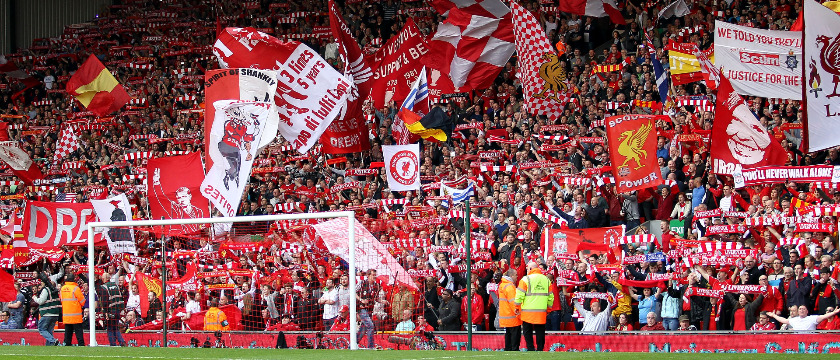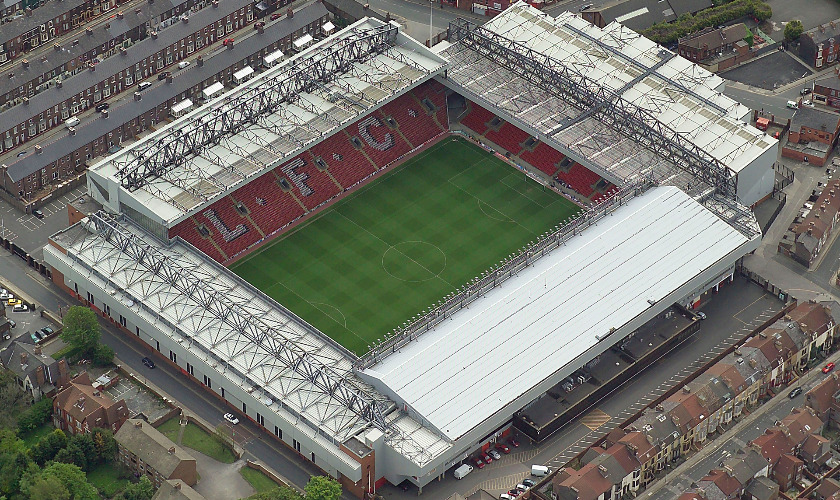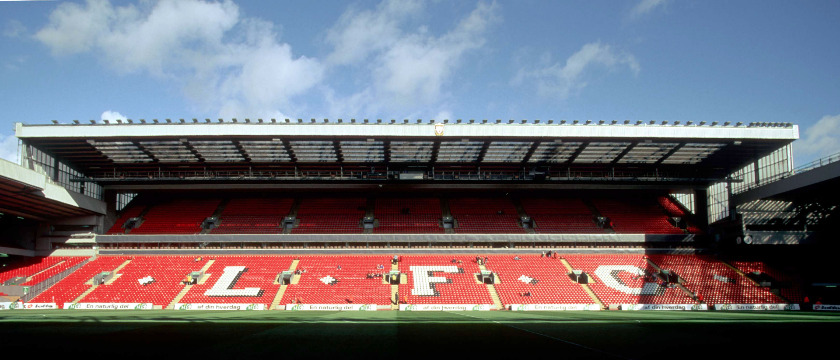Travel Guide for Liverpool and Anfield Stadium
Below you will find your perfect guide for going to England to watch Liverpool at Anfield!
Headlines from the travel guide:

LIVERPOOL HONOURS
First Division: 18 (last 1990)
FA Cup: 7 (last 2006)
League Cup: 8 (last 2012)
European Cup/Champions League: 5 (last 2005)
UEFA Cup: 3 (last 2001)
ANFIELD STADIUM
Pitch: 101 x 68
Opening match: 1 September 1892 (Liverpool – Rotherham 7-1)
Anfield Road
Liverpool
L4 0TH
ANFIELD STADIUM HISTORY
Liverpool FC have played at Anfield Road since the club was formed in 1892. A new stand for 3,000 people was built in 1895, where you today have main stand. Another stand was built after the club’s second league title 1906. This one was named Spion Kop and the name comes from a mountain in South Africa where a Liverpool regiment lost many men during the Boer War.
In 1928 the capacity of the Kop was extended to 30,000. In May 1994 it was the end of an era, when the stand was rebuilt and converted into an all-seater, in accordance with the Taylor Report recommendation after the Hillsborough disaster.
The highest attendance recorded at Anfield is from February 2, 1952 when 61,905 people came to witness an FA Cup game against Wolverhampton Wanderers.
The recent redevelopment of the Main Stand saw the capacity of Anfield significantly increased and with an additional 8,500 seats the Main Stand is now one of the largest all-seater grandstands.

ANFIELD DIRECTIONS
Bus:
17 from Queen Square Bus Station (near Lime Street Railway Station).
26 from Liverpool One Bus Station.
917 from St Johns Lane.
Soccer Bus:
Shuttle buses run from the Sandhills station (Merseyrail Northern Line). There are buses to Anfield for two hours before the match (last bus leaves 15 minutes before kickoff) and for 50 minutes after the final whistle.
The price for a single journey is £2. If they are bought with a train ticket the cost of a round-trip ticket is only £1.60.
Check out Mersey Travel: www.merseytravel.gov.uk
ANFIELD BARS
The Albert (105 Walton Breck Road) is a pub that’s a favourite among the Liverpool fans. it has a great atmosphere on match days and foreign Liverpool supporters are normally made to feel very welcome here. Across the road is another pub called The Park (194 Walton Beck Road).
The Arkles (77 Anfield Road) is a popular pub for both home and away fans. Both sets of supporters can have a drink together here, which usually creates a fantastic atmosphere.
Other popular pubs near Anfield are The Sandon (172-182 Oakfield Road) and Sam Dodd’s Wine Bar (166-172 Oakfield Road).
An entirely different option is Alma de Cuba (St Peter’s Church, Seel Street), a restaurant and music bar situated in an old church building.
Official fan zones open four hours before kick off with food and drink and live music. They are located on Anfield Road and at Paisley Square.
ANFIELD STADIUM TOUR
Daily: 10:00 – 15:00
Admission including museum with Steven Gerrard Collection:
£17.00 – adults
£14.00 – students and pensioners
£11.00 – children
£48.00 – family ticket (2 adults, 2 children)
Booking: www.stadiumtours.liverpoolfc.com/tours
There are also legends tours available where a Liverpool hero will be your tour guide.
ANFIELD MUSEUM
The museum is inside the Kop Stand, behind the statue of Bill Shankly.
The club has an interactive museum, the Liverpool FC Story. It now features the Steven Gerrard Collection – an exhibition showcasing memorabilia from the Liverpool legend’s personal collection.
OPENING TIMES
Daily: 9:00 – 17:00
(last entry 16:00)
On matchdays the museum closes 60 minutes prior to kick off.
ADMISSION
£10:00 – adults
£ 8:00 – students and pensioners
£ 6.00 – children
£24.00: Family ticket (two adults, two children
LIVERPOOL STORES OPENING TIMES
Official Club store
Anfield Road
Liverpool
L4 0TH
Monday – Saturday: 9:00 – 17:00
Sunday: 10:00 – 16:00
Williamson Square Club Store
11 Williamson Square
Liverpool
L1 1EQ
Monday – Saturday: 9.:00 – 17:30
Sunday: 10:00 – 16:00
Opening times vary before and after the game.
Liverpool ONE store
Liverpool ONE shopping centre
L1 8BU
Monday – Friday: 9:30 – 20:00
Saturday: 9:00 – 19:00
Sunday: 11:00 – 17:00

LIVERPOOL TRAINING GROUND
Liverpool’s training complex, Melwood is located in West Derby. The club have been there since the days of Bill Shankly in the 1950s. Previously the area belonged to a school where two priests used to teach the kids how to play football. The two priests were called Melling and Woodlock, and from there comes the name Melwood.
Back in the old days players used to have to go to Anfield to register, and then head off to Melwood for training. After the training they had to go back to Anfield to shower and eat.
Today Melwood is a top class training complex with all the facilities you can think of. The training ground includes first class grass- and artificial pitches, rehabilitation pool, massage area, gymnasium, jacuzzi and even a hypoxic chamber. it also has a restaurant and media room that can take up to 10 TV teams.
To get to Melwood you can take bus number 12 or 13 from Liverpool city centre, towards Stockbridge Village. There is a stop just outside the training complex. the address is Melwood Drive, West Derby, Liverpool.
Unfortunately, all you can hope to see are the players driving in or out of the complex, as training sessions tend to be closed to the public.
LIVERPOOL CLUB HISTORY
The history of Liverpool Football Club ironically starts with the team that today are their local rivals, Everton. Back in the 1800s the church had a big influence on the life of working class people and its families. A good Christian was supposed to keep fit and healthy by doing sports. St Domingo’s Parish and Sunday School was formed in 1870, where children as well as adults could play such games as cricket and baseball. Rugby was the main sport during the winter but it soon started to lose out to another sport that became increasingly popular, football. In 1878 St Domingo’s Football Club was formed. A year later the club renamed themselves Everton Football Club.
The team played their first games on a public football pitch in Stanley Park. Soon the league they were playing in and its board members (Lancashire Association) demanded that Everton move to a more modern stadium, in Priory Road.
In 1884 the brewery owner John Houlding, a big lover of football and very involved with Everton, arranged a meeting at his pub The Sandon. A decision was taken to move their home ground from Priory Road to a pitch at Anfield Road,
Everton grew quickly and the club’s big financer John Houlding enjoyed the success. However, as time went on members of the board and players started to feel that “King John” was running his own show. Among other things he demanded that the players would get changed at his pub and he would have sole rights for selling ale at Anfield.
In September 1891 King John suggested that Everton FC should buy Anfield and some land he owned adjoining the ground. However members voted against him and Everton had to leave Anfield for Goodison Park. They took lock, stock and barrel with them.
Liverpool form at Anfield
John, and a few other members that didn’t move with the club, stayed at Anfield and started up a new club. Liverpool FC was formed on March 15, 1892.
The Irishman “Honest” John McKenna became manager and with a £500 loan from John Houlding – that was never paid back – over a dozen players were recruited from Scotland. Liverpool FC became known as “The team of all the Macs”. The transfers turned out to be a success and Liverpool won their first competitive game 8-0 against Higher Walton.
Liverpool won their first league title in 1901. The first FA Cup win came 64 years later, in 1965, and by then Liverpool had already secured six league titles. The victory came after Bill Shankly’s team defeated Leeds 2-1 in a final where all the goals were scored during extra time.
Bill Shankly was clearest of all on the values that have made Liverpool into a unique club. He summarised his views on football and life like this:
“The socialism i believe in is not really politics. it is a way of living. it is humanity. i believe the only way to live and to be truly successful is by collective effort, with everyone working for each other, everyone helping each other, and everyone having a share of the rewards at the end of the day. That might be asking a lot, but it’s the way I see football and the way I see life.”
Liverpool win first European Cup
The next legendary Liverpool manager after Bill Shankly was Bob Paisley who brought Liverpool their first European Cup title, when Liverpool defeated Borussia Mönchengladbach 3-1 in Rome in 1977. The game was Kevin Keegan ́s last in a Liverpool shirt, but he had a splendid game. He got past Berti Vogts time after time. With eight minutes to go and Liverpool holding on to a 2-1 lead, Keegan was brought down in the penalty area by an exhausted and very frustrated Berti Vogts. Phil Neal, backed by tens of thousands of Liverpudlians inside Stadio Olimpico, made no mistake from the spot and Keegan got to end his fantastic Liverpool career as a European Champion.
Kenny Dalglish, who replaced Kevin Keegan, went on to win 15 titles with the club. Liverpool continued to dominate European football for almost a decade and won the European Cup in 1978, 1981 and 1984.
However the era came to a tragic ending at the Heysel stadium in Brussels on May 29, 1985. The fact that Liverpool lost 1-0 to Juventus was of little concern that evening when 39 people in the crowd lost their lives. The aftermath of this disaster led to all English clubs being banned from international competitions for five years, and Liverpool for an additional year.
In their first season with Kenny Dalglish as player manager in 1985/6, Liverpool went on to win both the league and the FA Cup. On top of that the victory in the FA Cup final came against their bitter Merseyside rivals, Everton. Liverpool were 1-0 down at half time, but after two goals from Ian Rush and one by Craig Johnston Liverpool secured their third FA Cup title and also “the Double” – winning the league and the FA Cup during the same season.
Liverpool’s darkest day
The darkest chapter in Liverpool’s history was written April 15, 1989. On a terraceat Hillsborough in Sheffield 96 of the club’s supporters died. The lack of safety in the stadium was highlighted in the Taylor Report. This led to a major overhaul and reconstruction of venues around the UK.
In 2001 Liverpool won their third title of the season with a Golden Goal at Westfalenstadion in Dortmund. the Spanish side Alavés were defeated 5-4 in a goalfest that has gone down in Liverpool’s history as one of the greatest games. The other two titles were won at the Millennium Stadium in Cardiff: the League Cup against Birmingham on penalties and in the FA Cup against Arsenal through two late Michael Owen goals in the 83rd and 88th minute, after Freddie Ljungberg had put Arsenal 1-0 up. It was a season of small margins, but major victories for Liverpool FC.
Liverpool’s greatest victory in Istanbul
We finish off with the greatest victory of them all. In 2005 Liverpool came back from being 3-0 down in the Champions League final against AC Milan in Istanbul. Maradona said after the game: “Not even Brazil’s World Cup winning side from 1970 would have been able to come back from being 3-0 down against AC Milan.” But Liverpool did.
After being totally outplayed in the first half Liverpool came out as a whole new team to the second half. One major factor was manager Rafa Benitez’ decision to put Dieter “the Kaiser” Hamann up in midfield to close down Kaka.
Another, the most important one, was the backing the Liverpool team got from the world’s greatest and most loyal fans. Who in their right minds could hang their heads or considering giving up with 40,000 supporters signing You’ll Never Walk Alone behind them, despite being 3-0 down against AC Milan?
Johan Cruyff was in the stands and said: “There’s not one club in the world so united with the fans. For that I admire Liverpool more than anything.”
Three quick goals in the second half and a phenomenal double save from Jerzy Dudek at the end of extra time took the game to penalties. As they say, the rest is history and in this case – great football history…
Less recent success
After the miracle of Istanbul success has been in short supply. Two cup titles – the FA Cup in 2006 and the League Cup in 2012 – are all the Kop has been able to rejoice.
However hopes for better times were raised when Borussia Dortmund’s dynamic manager Jürgen Klopp took over the helm at Anfield. The first season saw two cup finals but unfortunately defeats in both the League Cup and Europa League.
In 2017-18 Klopp’s Liverpool embarked on an incredible European adventure. As the Champions League moved to knockout stages the Reds moved up a gear as they thrashed Porto 5-0 in Portugal, then beat the mighty Manchester City home and away to secure a 5-1 aggregate winning score in the quarter-finals. Roma were next – and in an unforgettable night under the Anfield floodlights, Liverpool raced into a five goal lead. They eventually clung on to win 7-6 over two legs.
Liverpool fans headed in huge numbers for the final in Kyiv. Sadly their star striker Mo Salah was injured early on and they lost 3-1 to Real Madrid – however it confirmed Liverpool were once again a force to be reckoned with on the European stage.
LIVERPOOL FACTS
The Scot Billy Liddell remained at Liverpool for his entire career and scored 228 goals in 534 games. Undoubtedly he would have reached even higher numbers for both had it not have been for the war. However when the league finally started up again for the season 1946/47 Liverpool and Billy Liddell became champions.
When Liverpool were about to play their first FA Cup final at Wembley in 1950, the club were allocated 10,000 tickets. The demand was huge and over 100,000 applications for tickets were sent in to Liverpool. Despite losing the game to Arsenal they were given a fantastic reception on their return. Over 100,000 people lined the streets of Liverpool to welcome their heroes.
Phil Neal played 417 games in a row for Liverpool, from October 23, 1976 to September 24, 1983. The all-time appearance record in the Liverpool shirt, is however, held by a more unknown man, Elisha Scott. He represented Liverpool for a period of 21 years and 52 days (1913 – 1934).
Ian Rush has scored most goals – in 660 matches he found the net 346 times. Four of these were at Goodison Park on November 6, 1982 when Everton were crushed 5-0.
Another goal related record is held by “the Great Dane” Jan Molby, 42 goals from penalties.
You’ll Never Walk Alone
You’ll Never Walk Alone is one of the most famous anthems in the world of football. The song is today associated with the Kop more than anything else and Liverpool even have the words printed on their badge.
As you walk through a storm
Hold your head up high
And don’t be afraid of the dark
At the end of the storm
There’s a golden sky
And the sweet silver song of a lark
Walk on through the wind
Walk on through the rain
Though your dreams be tossed and blown
Walk on, walk on, with hope in your heart
And you’ll never walk alone
You’ll never walk alone